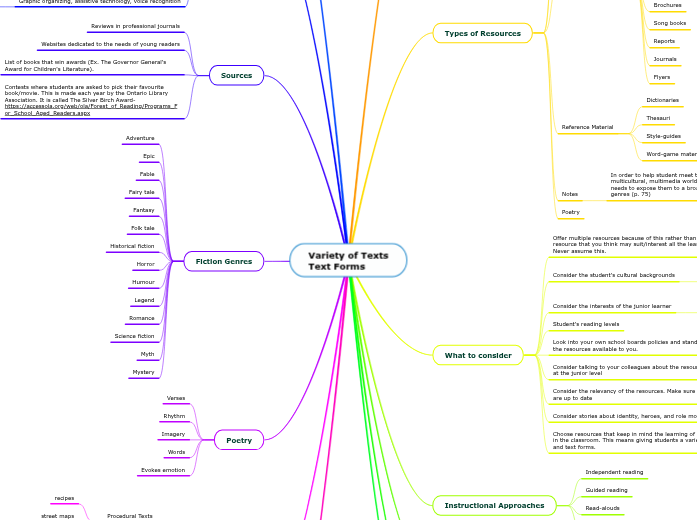Variety of Texts
Text Forms
Technology
Technology gives students opportunities to explore and make connections with the world that they live in.
Technology supports lifelong learning
Can be used in lessons to support learning ie. digital learning
Computers, laptops, iPads, chromebooks, SmartBoards are some examples of the technologies used in junior classrooms.
Types of Resources
Fiction
Non-Fiction
Multimedia resources
Computer access to websites
Electronic newspapers
Posters
Magazines
Comic books
Graphic novels
Picture books
Brochures
Song books
Reports
Journals
Flyers
Reference Material
Dictionaries
Thesauri
Style-guides
Word-game material
Notes
In order to help student meet the literacy demands of a multicultural, multimedia world, the classroom collection needs to expose them to a broad range of text forms and genres (p. 75)
Poetry
What to consider
Offer multiple resources because of this rather than one resource that you think may suit/interest all the learners. Never assume this.
Consider the student's cultural backgrounds
Language-books in the students first language is a helpful starting point. Especially for ESL/ELL students.
Consider the interests of the junior learner
Use a survey to find out the interests of the students in your classroom.
Make the students active participants in the process of selecting, organizing, and maintaining the classroom resources.
Student's reading levels
Look into your own school boards policies and standards about the resources available to you.
Consider talking to your colleagues about the resources used at the junior level
Consider the relevancy of the resources. Make sure that they are up to date
Consider stories about identity, heroes, and role models
Choose resources that keep in mind the learning of all learners in the classroom. This means giving students a variety of texts and text forms.
Instructional Approaches
Independent reading
Guided reading
Read-alouds
Shared reading
Non-Fiction Genres
Autobiography
Biography
Memoir
Why Variety?
Students need to see examples of good writing using different styles
Being exposed to different reading materials/variety of forms of text allows students to make connections between reading and writing
Being exposed to non-traditional books such as electronic and multimedia texts, allows students to assess materials critically
Mentor Texts
High-quality and well-written texts that can be used by teachers. They introduce students to a strategy, literary device, or text feature that students can use to remember how to apply the strategy.
Students read and imitate
Examples:
Strategy: questioning
Literary device: foreshadowing
Text feature: diagrams
Resources to Access Text Forms
Library
Ask the school librarian (teacher-librarian)
These librarians will help find a collection of resources that reflect the diverse reading levels, interests, and instructional needs of the students.
Public librarian
Internet
Devices
Computers
Digital Cameras
Video Cameras
Scanners
Cellphones can be used
VCR/DVD players
Audio recorders
Projectors/overheads
Give students opportunities to have shared reading and writing activities.
Translation programs
Notes
Allow students to have multiple ways of obtaining information from visual/various sources.
Graphic organizing, assistive technology, voice recognition
Great for students that have special accommodations for reading and/or writing
Sources
Reviews in professional journals
Websites dedicated to the needs of young readers
List of books that win awards (Ex. The Governor General's Award for Children's Literature).
Contests where students are asked to pick their favourite book/movie. This is made each year by the Ontario Library Association. It is called The Silver Birch Award- https://accessola.org/web/ola/Forest_of_Reading/Programs_For_School_Aged_Readers.aspx
Fiction Genres
Adventure
Epic
Fable
Fairy tale
Fantasy
Folk tale
Historical fiction
Horror
Humour
Legend
Romance
Science fiction
Myth
Mystery
Poetry
Verses
Rhythm
Imagery
Words
Evokes emotion
Common Texts
Procedural Texts
recipes
street maps
instructional manuals
Reports
magazines and newspaper articles
research reports
critical reviews
essays
diaries or journals
Functional Texts
grocery and other lists
Invitations
Advertisements
Business letters
Scripts
